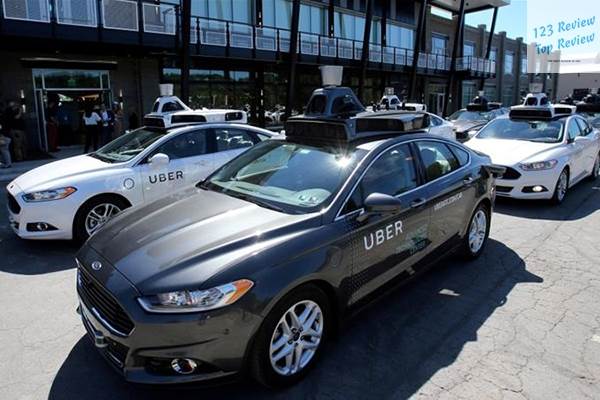In this article, 123 Review delves into the current state of autonomous vehicle technology, examining its development, implementation, and impact on various sectors such as urban planning, safety, and the economy. We will explore the key players in the industry, regulatory challenges, and the public’s perception of this groundbreaking technology. From the bustling streets of Silicon Valley to the testing grounds of Arizona, join us as we navigate the road ahead for self-driving cars in America.
Current State of Self-Driving Cars
Overview of Technology Advancements
Self-driving cars, also known as autonomous vehicles (AVs), represent one of the most significant technological advancements in modern transportation. These vehicles use a combination of sensors, cameras, radar, and LiDAR to perceive their surroundings and make real-time driving decisions. At the core of this technology are advanced algorithms and artificial intelligence (AI) that process the vast amounts of data collected by these sensors to navigate complex environments safely.

Autonomous vehicles are classified into different levels of automation by the Society of Automotive Engineers (SAE), ranging from Level 0 (no automation) to Level 5 (full automation). Currently, most commercially available AVs operate at Level 2 or Level 3, where the vehicle can manage certain driving tasks but still requires human oversight. However, rapid advancements are pushing towards higher levels of autonomy, with several companies testing Level 4 and Level 5 vehicles in controlled environments.
Key Players in the Market
The self-driving car market in the United States is highly competitive, with several key players leading the charge. Waymo, a subsidiary of Alphabet Inc., has been at the forefront of AV development, with millions of miles driven on public roads and a growing fleet of autonomous taxis in cities like Phoenix, Arizona. Tesla, renowned for its electric vehicles, continues to develop and enhance its Autopilot and Full Self-Driving (FSD) systems, integrating them into its cars and aiming for higher levels of autonomy.
Cruise, backed by General Motors, focuses on creating a fully autonomous, electric ride-sharing service. The company has made significant strides in deploying AVs in urban environments and is actively testing its technology in San Francisco. Other notable players include Uber’s Advanced Technologies Group (now part of Aurora), Aptiv, and Argo AI, each contributing to the dynamic and rapidly evolving AV landscape.
Recent Developments in Legislation
Legislation surrounding self-driving cars is crucial for their deployment and adoption. The National Highway Traffic Safety Administration (NHTSA) has issued guidelines to ensure the safe testing and deployment of AVs, emphasizing the importance of safety assessments and data sharing. At the federal level, there have been efforts to standardize regulations, although much of the regulatory power currently resides with individual states.
California, for example, has stringent requirements for AV testing, including the need for companies to obtain permits and report disengagements (instances where a human driver must take control). Arizona, on the other hand, has adopted a more relaxed approach, encouraging AV companies to test their vehicles with fewer regulatory hurdles. States like Florida and Texas are also emerging as key locations for AV testing, each with its own set of regulations to balance innovation and public safety.
State-by-State Policies and Regulations
The regulatory environment for self-driving cars varies significantly from state to state. In California, the Department of Motor Vehicles (DMV) oversees the testing and deployment of autonomous vehicles, requiring companies to submit detailed reports on disengagements and accidents. This transparency aims to build public trust and ensure safety on the roads.
Arizona’s more permissive regulatory framework has attracted numerous AV companies, making it a hotspot for testing. The state’s policies are designed to foster innovation while maintaining safety standards. In Texas, AV legislation is supportive, with the state allowing autonomous vehicles to operate on public roads without a human driver present, provided they comply with federal and state traffic laws.
Florida has also positioned itself as a leader in AV testing, with legislation that supports the development and deployment of autonomous vehicles. The state allows AVs to operate on public roads and encourages partnerships between AV companies and local governments to pilot innovative transportation solutions. Each state’s approach reflects its priorities and vision for the future of transportation.
Public Awareness and Perception
Public awareness and perception of self-driving cars play a critical role in their acceptance and adoption. While there is growing interest in autonomous vehicles, public opinion is mixed, with safety concerns being the primary hesitation. According to surveys, many people are intrigued by the convenience and potential safety benefits of AVs but remain cautious about their reliability and performance in real-world scenarios.
Educational initiatives and transparent communication from AV companies are essential to address these concerns. Demonstrating the safety and reliability of AVs through extensive testing, real-world deployments, and public engagement can help build trust. As people become more familiar with the technology and see its benefits firsthand, public perception is likely to shift towards greater acceptance.
Safety and Ethical Considerations
Safety Benefits of Autonomous Vehicles
The potential safety benefits of autonomous vehicles are significant. Human error is responsible for the vast majority of traffic accidents, and self-driving cars have the potential to drastically reduce these incidents. AVs are designed to adhere strictly to traffic laws, maintain safe following distances, and react faster than human drivers to changing road conditions.
Advanced driver-assistance systems (ADAS) incorporated into AVs can enhance situational awareness, improve reaction times, and prevent collisions. Features like automatic emergency braking, lane-keeping assist, and adaptive cruise control are already making roads safer. As technology progresses towards higher levels of autonomy, the potential for reducing traffic accidents and fatalities becomes even greater.
Challenges in Ensuring Safety
Despite their potential, ensuring the safety of self-driving cars presents several challenges. AVs must be able to handle a wide range of driving conditions, including adverse weather, complex urban environments, and interactions with unpredictable human drivers. Developing robust algorithms and safety protocols that can account for these variables is a formidable task.
Moreover, extensive testing is required to validate the performance and safety of AV systems. This includes both simulation-based testing and real-world trials. Companies must continuously refine their technology to address edge cases and improve reliability. Collaboration between AV developers, regulatory bodies, and independent safety organizations is essential to establish and maintain high safety standards.
Ethical Dilemmas in Decision-Making
Autonomous vehicles face ethical dilemmas, particularly in scenarios where harm is unavoidable. For instance, if an AV encounters a situation where it must choose between the safety of its passengers and that of pedestrians, how should it decide? These ethical considerations are complex and require careful thought and consensus among developers, ethicists, and policymakers.
The programming of AVs to make ethical decisions involves defining priorities and values that guide their actions. Developing ethical frameworks and guidelines for AV decision-making is an ongoing area of research and debate. Addressing these ethical challenges is crucial to gaining public trust and ensuring that autonomous vehicles operate in a manner consistent with societal values.
Case Studies of Accidents
Examining case studies of accidents involving self-driving cars provides valuable insights into the challenges and areas for improvement. High-profile incidents, such as the fatal crash involving an Uber self-driving car in Arizona, highlight the need for rigorous testing and stringent safety measures. Investigations into these accidents reveal critical failures and inform the development of more resilient and reliable AV technologies.
For example, the Uber crash in Arizona underscored the importance of robust sensor systems and fail-safe mechanisms. The investigation revealed that the vehicle’s software had failed to correctly identify the pedestrian, leading to a tragic outcome. Analyzing these incidents helps identify weaknesses in current systems and drives the continuous improvement of AV technologies.
Regulatory Measures to Address Safety
Regulatory measures play a vital role in ensuring the safety of self-driving cars. Federal and state agencies are actively working on establishing comprehensive safety standards and testing protocols. The NHTSA’s Autonomous Vehicle Policy Framework outlines guidelines for safety assessments, emphasizing the need for transparency and accountability.
States are also implementing their own regulations to address safety concerns. For example, California’s DMV requires AV companies to report disengagements and accidents, providing valuable data to assess the technology’s performance. Collaboration between government bodies and AV developers is essential to create a robust regulatory environment that promotes innovation while prioritizing safety.
Economic Impact of Self-Driving Cars
Job Displacement in the Transportation Sector
The rise of self-driving cars is expected to lead to job displacement in the transportation sector. Professions such as truck drivers, taxi drivers, and delivery personnel may face significant disruptions as autonomous vehicles become more prevalent. However, this displacement is likely to occur gradually, allowing time for workforce retraining and adaptation to new job roles in emerging sectors.
The shift towards automation in transportation could impact millions of jobs, necessitating proactive measures to support affected workers. Governments and industries must invest in retraining programs to help displaced workers transition to new employment opportunities. Additionally, policies that promote job creation in sectors related to AV technology and infrastructure will be crucial.
New Job Creation Opportunities
While some jobs may be displaced, the advent of self-driving cars also presents opportunities for new job creation. The development, manufacturing, and maintenance of autonomous vehicles require a skilled workforce in areas such as software engineering, data analysis, and cybersecurity. Additionally, industries supporting AV infrastructure, such as smart traffic management and vehicle-to-everything (V2X) communication systems, will see increased demand for skilled professionals.
Moreover, new business models and services are likely to emerge around AV technology. For instance, autonomous ride-sharing and delivery services will create jobs in fleet management, customer service, and logistics. The growth of AV technology will spur innovation and entrepreneurship, leading to the creation of new industries and job opportunities.
Impact on Insurance Industry
The insurance industry will undergo significant changes with the adoption of self-driving cars. Traditional auto insurance models may need to be redefined as liability shifts from drivers to manufacturers and technology providers. Insurance companies will need to develop new risk assessment methodologies and pricing models that account for the advanced safety features and lower accident rates associated with autonomous vehicles.
As AVs reduce the frequency and severity of accidents, insurance premiums for autonomous vehicles may decrease. However, new types of coverage will emerge, such as cybersecurity insurance to protect against hacking and software failures. The insurance industry will need to adapt to the evolving risk landscape and collaborate with AV developers to ensure comprehensive coverage for autonomous vehicles.
Potential for Cost Savings for Consumers
Self-driving cars have the potential to generate significant cost savings for consumers. Reduced accident rates can lead to lower insurance premiums, while efficient driving algorithms can optimize fuel consumption and minimize maintenance costs. AVs can also reduce the need for car ownership, as autonomous ride-sharing services offer a convenient and cost-effective alternative to personal vehicles.
The integration of autonomous vehicles into shared mobility services can lower transportation costs for individuals. Instead of owning and maintaining a car, consumers can rely on AV services for their transportation needs, paying only for the rides they take. This shift can lead to substantial savings on vehicle purchase, maintenance, fuel, and insurance.
Effects on Urban Planning and Infrastructure
The integration of self-driving cars will have profound effects on urban planning and infrastructure. Cities may need to redesign roadways, traffic management systems, and parking facilities to accommodate autonomous vehicles. The reduced need for parking spaces and more efficient traffic flow could lead to more green spaces and improved urban environments.
AVs can enhance accessibility for people with disabilities and the elderly, promoting inclusive urban mobility. Smart infrastructure, such as intelligent traffic lights and connected roadways, will improve traffic efficiency and safety. Urban planners will need to consider the impact of AVs on land use, zoning, and public transportation systems to create sustainable and livable cities.
Future Trends and Innovations
Emerging Technologies in Autonomous Driving
The future of self-driving cars is marked by emerging technologies that promise to enhance their capabilities. Innovations such as advanced AI algorithms, enhanced sensor systems, and V2X communication are expected to further improve the safety and efficiency of autonomous vehicles. Continuous research and development in these areas will drive the evolution of AV technology, making self-driving cars more reliable and accessible.
AI and machine learning play a pivotal role in advancing AV technology. These technologies enable AVs to learn from vast amounts of data, continuously improving their performance and decision-making capabilities. Advanced AI algorithms enhance object recognition, predict traffic patterns, and optimize navigation routes, contributing to safer and more efficient autonomous driving.
Predictions for Market Growth
Market analysts predict significant growth in the self-driving car industry over the next decade. As technology matures and regulatory frameworks become more supportive, the adoption of autonomous vehicles is expected to accelerate. The market for self-driving cars, including both personal ownership and shared mobility services, is projected to reach substantial revenue figures, driven by consumer demand and technological advancements.
The commercialization of AV technology will create new revenue streams for companies involved in the development and deployment of autonomous vehicles. Ride-sharing services, logistics, and delivery services are expected to be major drivers of market growth. The global AV market is poised to expand as countries around the world embrace autonomous driving technology.
Integration with Smart City Initiatives
Self-driving cars are a key component of smart city initiatives, which aim to leverage technology to create more efficient, sustainable, and livable urban environments. AVs can contribute to smart city goals by reducing traffic congestion, lowering emissions, and improving public transportation systems. The integration of AVs with smart infrastructure, such as intelligent traffic lights and connected roadways, will enhance urban mobility and quality of life.
Smart city initiatives seek to optimize urban resources and improve the overall efficiency of city operations. AVs can play a critical role in these initiatives by providing real-time data on traffic conditions, enabling dynamic traffic management, and reducing the need for extensive road infrastructure. The collaboration between AV developers, city planners, and policymakers is essential to realize the full potential of smart cities.
Environmental Considerations and Sustainability
Environmental considerations are crucial in the development and deployment of self-driving cars. AVs have the potential to reduce greenhouse gas emissions through optimized driving patterns and increased use of electric vehicles. Autonomous vehicles can improve fuel efficiency by maintaining steady speeds, reducing idling, and minimizing aggressive driving behaviors.
The adoption of shared autonomous mobility services can reduce the overall number of vehicles on the road, further contributing to environmental sustainability and reducing the carbon footprint of transportation. Additionally, AVs can support the integration of renewable energy sources into the transportation sector by aligning with electric vehicle (EV) infrastructure. Sustainable practices and technologies will be integral to the future of autonomous driving.
The Role of AI and Machine Learning
AI and machine learning are central to the advancement of self-driving cars. These technologies enable AVs to learn from vast amounts of data, continuously improving their performance and decision-making capabilities. AI-driven algorithms enhance object recognition, predict traffic patterns, and optimize navigation routes, contributing to safer and more efficient autonomous driving.
Machine learning techniques allow AVs to adapt to changing environments and improve over time. For example, reinforcement learning algorithms enable AVs to learn from trial and error, refining their behavior based on past experiences. The ongoing integration of AI and machine learning will drive the evolution of self-driving cars, making them safer, more efficient, and more intelligent.
Consumer Adoption and Market Analysis
Factors Influencing Consumer Acceptance
Several factors influence consumer acceptance of self-driving cars, including safety, cost, convenience, and trust in technology. Public education campaigns, transparent communication from AV companies, and positive real-world experiences will be essential in building consumer confidence. Demonstrating the safety and reliability of autonomous vehicles through rigorous testing and successful deployment will also play a crucial role in driving consumer acceptance.
Affordability is another critical factor. As the cost of AV technology decreases, it will become more accessible to a broader range of consumers. Additionally, the convenience and efficiency of autonomous vehicles can appeal to consumers looking for hassle-free transportation options. Trust in technology will grow as AVs prove their reliability and safety on the roads.
Barriers to Widespread Adoption
Despite the potential benefits, there are barriers to the widespread adoption of self-driving cars. These include regulatory hurdles, high development and deployment costs, and public skepticism about the safety and reliability of AVs. Addressing these barriers requires collaboration between industry stakeholders, government bodies, and the public to create an environment conducive to the growth and acceptance of autonomous vehicles.
Regulatory uncertainty can hinder the deployment of AVs, as companies navigate a patchwork of state and federal regulations. High development costs pose another challenge, requiring substantial investment in research, testing, and infrastructure. Public skepticism, fueled by concerns about safety and ethical considerations, must be addressed through transparent communication and successful real-world deployments.
Market Analysis of Self-Driving Services
The market for self-driving services is expanding rapidly, with ride-sharing and delivery services leading the way. Companies like Waymo, Uber, and Lyft are investing heavily in autonomous vehicle technology to offer convenient and cost-effective transportation solutions. Market analysis indicates a growing demand for self-driving services, driven by urbanization, increasing consumer preferences for ride-sharing, and the potential for enhanced mobility solutions.
Autonomous ride-sharing services are expected to become a significant segment of the AV market, offering consumers an alternative to traditional car ownership. Delivery services, including last-mile delivery and logistics, are also poised to benefit from AV technology, improving efficiency and reducing costs. The growth of self-driving services will drive innovation and competition in the transportation sector.
Comparisons with Traditional Transportation Options
Comparisons with traditional transportation options highlight the advantages of self-driving cars in terms of safety, efficiency, and convenience. Autonomous vehicles can reduce the risk of accidents caused by human error, provide consistent and reliable transportation services, and offer greater flexibility in route planning. However, challenges such as the high initial cost of AVs and the need for substantial infrastructure investments remain.
Self-driving cars can enhance mobility for individuals who cannot drive, such as the elderly and people with disabilities. They can also reduce the time spent on commuting and improve overall travel efficiency. As technology advances and costs decrease, AVs are expected to become a more attractive alternative to traditional transportation options.
Future of Ownership vs. Ride-Sharing Models
The future of self-driving cars will likely see a shift from traditional car ownership to ride-sharing and mobility-as-a-service (MaaS) models. Autonomous ride-sharing services can offer cost-effective and convenient transportation solutions, reducing the need for individuals to own private vehicles. This shift could lead to decreased vehicle ownership rates, more efficient use of transportation resources, and reduced environmental impact.
Companies like Uber and Lyft are already exploring and investing in autonomous ride-sharing services, indicating a significant trend towards shared mobility solutions. The MaaS model can provide consumers with flexible and affordable transportation options, while reducing the overall number of vehicles on the road. This transition will require changes in infrastructure, business models, and consumer behavior, but holds the potential to transform the transportation landscape.
Conclusion
Self-driving cars represent a transformative shift in the transportation landscape of the United States. With rapid advancements in technology, evolving legislation, and growing public awareness, the future of autonomous vehicles looks promising. While challenges related to safety, ethics, and economic impact need to be addressed, the potential benefits of self-driving cars in terms of safety, efficiency, and sustainability are immense. As the industry continues to innovate and adapt, self-driving cars are poised to play a central role in shaping the future of transportation.





